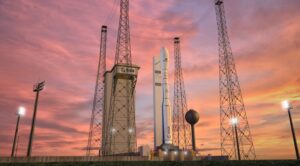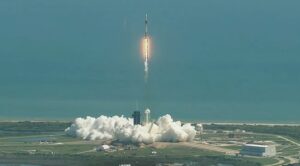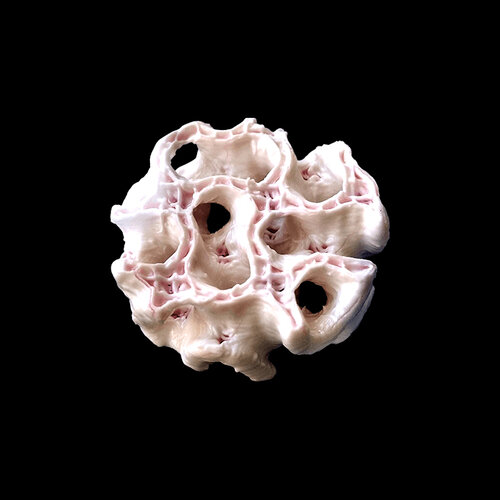New Solar observations could help develop better solar thermometer
Saturday, 09 April 2022 04:04 A sophisticated new observation of a cool zone on the surface of the sun could help scientists develop a new kind of solar thermometer.
A team of astrophysicists led by researchers from the University of Glasgow are the first to use observations from the ALMA observatory in Chile to estimate the temperature of a solar prominence.
Solar prominences are zones of plasma on the surface o
A sophisticated new observation of a cool zone on the surface of the sun could help scientists develop a new kind of solar thermometer.
A team of astrophysicists led by researchers from the University of Glasgow are the first to use observations from the ALMA observatory in Chile to estimate the temperature of a solar prominence.
Solar prominences are zones of plasma on the surface o US, Russia Should Cooperate on Leveraging Private Investment for Space Programs - Expert
Saturday, 09 April 2022 04:04 Russia and the United States along with other countries should cooperate on leveraging private investment to develop human spaceflight programs as governments struggle with tight budgets, said Greg Autry, professor of space leadership at Arizona State University's Thunderbird School of Global Management.
"I think it is time for Russia to fully embrace the commercial future of space. With i
Russia and the United States along with other countries should cooperate on leveraging private investment to develop human spaceflight programs as governments struggle with tight budgets, said Greg Autry, professor of space leadership at Arizona State University's Thunderbird School of Global Management.
"I think it is time for Russia to fully embrace the commercial future of space. With i Ten new gravitational waves found in LIGO-Virgo's O3a data
Saturday, 09 April 2022 04:04 In the last seven years, scientists at the LIGO-Virgo Collaboration (LVC) have detected 90 gravitational waves signals. Gravitational waves are perturbations in the fabric of spacetime that race outwards from cataclysmic events like the merger of binary black holes (BBH). In observations from the first half of the most recent experimental run, which continued for six months in 2019, the collabor
In the last seven years, scientists at the LIGO-Virgo Collaboration (LVC) have detected 90 gravitational waves signals. Gravitational waves are perturbations in the fabric of spacetime that race outwards from cataclysmic events like the merger of binary black holes (BBH). In observations from the first half of the most recent experimental run, which continued for six months in 2019, the collabor Vega C to launch Sentinel-1C in 2023
Friday, 08 April 2022 21:50
The European Space Agency will launch its Sentinel-1C radar imaging satellite on a Vega C rocket in 2023 as the agency continues to study potential impacts of Russia’s invasion of Ukraine on that launch vehicle.
Differences between the Moon's near and far sides linked to colossal ancient impact
Friday, 08 April 2022 17:35
The face that the Moon shows to Earth looks far different from the one it hides on its far side. The nearside is dominated by the lunar mare—the vast, dark-colored remnants of ancient lava flows. The crater-pocked far side, on the other hand, is virtually devoid of large-scale mare features.
SpaceX launches 3 visitors to space station for $55M each
Friday, 08 April 2022 16:06
SpaceX launched three rich businessmen and their astronaut escort to the International Space Station on Friday for more than a week's stay, as NASA joins Russia in hosting guests at the world's most expensive tourist destination.
It's SpaceX's first private charter flight to the orbiting lab after two years of carrying astronauts there for NASA.
Arriving at the space station Saturday are an American, a Canadian and an Israeli who run investment, real estate and other companies. They're paying $55 million apiece for the rocket ride and accommodations, all meals included.
Russia has been hosting tourists at the space station—and before that the Mir station—for decades.
Mission design of an aperture-synthetic interferometer system for space-based exoplanet exploration
Friday, 08 April 2022 15:58
The search for extraterrestrial life and exploration of "another Earth" is an eternal theme for humans and inspires generations of planetary scientists. It not only improves our understanding of the formation and evolution of planets during the formation of a star system but also helps scientists to investigate the possible conditions and criteria of the existence of life. In the past 30 years, scientists have discovered more than 4,000 exoplanets, but exploration still has a long way to go.
Due to the far distance, searching for exoplanets requires high sensitivity and high resolution.
First private mission launches for International Space Station
Friday, 08 April 2022 15:05 The first fully private mission to the International Space Station blasted off from Florida Friday with a four-member crew from startup company Axiom Space.
The partnership has been hailed by NASA, which sees it as a key step in its goal to commercialize the region of space known as "Low Earth Orbit," leaving the agency to focus on more ambitious endeavors deeper into the cosmos.
A S
The first fully private mission to the International Space Station blasted off from Florida Friday with a four-member crew from startup company Axiom Space.
The partnership has been hailed by NASA, which sees it as a key step in its goal to commercialize the region of space known as "Low Earth Orbit," leaving the agency to focus on more ambitious endeavors deeper into the cosmos.
A S SpaceX launches commercial mission to ISS
Friday, 08 April 2022 14:36
SpaceX launched a Crew Dragon spacecraft April 8 carrying four commercial astronauts to the International Space Station for Axiom Space.
The post SpaceX launches commercial mission to ISS appeared first on SpaceNews.
Week in images: 4-8 April 2022
Friday, 08 April 2022 12:15
Week in images: 4-8 April 2022
Discover our week through the lens
Watch live: media Q&A with Samantha Cristoforetti
Friday, 08 April 2022 11:15
Tune in this Monday 11 April from 15:00-16:30 CEST (13:00-14:30 GMT) for a conversation between ESA astronaut Samantha Cristoforetti and media in Europe live on ESA Web TV.
Earth from Space: Sindh, Pakistan
Friday, 08 April 2022 07:00
The Copernicus Sentinel-2 mission takes us over part of Sindh – the third-largest province of Pakistan.
First private mission readies for launch to ISS
Friday, 08 April 2022 06:25 The first fully private mission to the International Space Station is set to blast off Friday with a four-member crew from startup company Axiom Space.
The partnership has been hailed by NASA, which sees it as a key step in its goal to commercialize the region of space known as "low Earth orbit," leaving the agency to focus on more ambitious endeavors deeper into the cosmos.
Takeoff is s
The first fully private mission to the International Space Station is set to blast off Friday with a four-member crew from startup company Axiom Space.
The partnership has been hailed by NASA, which sees it as a key step in its goal to commercialize the region of space known as "low Earth orbit," leaving the agency to focus on more ambitious endeavors deeper into the cosmos.
Takeoff is s NASA's Curiosity Mars rover reroutes away from 'Gator-Back' rocks
Friday, 08 April 2022 06:25 NASA's Curiosity Mars rover spent most of March climbing the "Greenheugh Pediment" - a gentle slope capped by rubbly sandstone. The rover briefly summited this feature's north face two years ago; now on the pediment's southern side, Curiosity has navigated back onto the pediment to explore it more fully.
But on March 18, the mission team saw an unexpected terrain change ahead and realized
NASA's Curiosity Mars rover spent most of March climbing the "Greenheugh Pediment" - a gentle slope capped by rubbly sandstone. The rover briefly summited this feature's north face two years ago; now on the pediment's southern side, Curiosity has navigated back onto the pediment to explore it more fully.
But on March 18, the mission team saw an unexpected terrain change ahead and realized 

 Image:
3D-printed bone
Image:
3D-printed bone